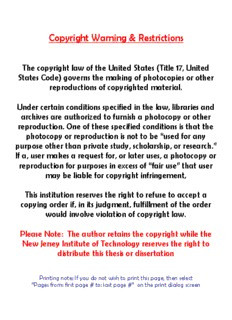
Design for productivity using GD&T - New Jersey Institute of PDF
Preview Design for productivity using GD&T - New Jersey Institute of
Copyright Warning & Restrictions The copyright law of the United States (Title 17, United States Code) governs the making of photocopies or other reproductions of copyrighted material. Under certain conditions specified in the law, libraries and archives are authorized to furnish a photocopy or other reproduction. One of these specified conditions is that the photocopy or reproduction is not to be “used for any purpose other than private study, scholarship, or research.” If a, user makes a request for, or later uses, a photocopy or reproduction for purposes in excess of “fair use” that user may be liable for copyright infringement, This institution reserves the right to refuse to accept a copying order if, in its judgment, fulfillment of the order would involve violation of copyright law. Please Note: The author retains the copyright while the New Jersey Institute of Technology reserves the right to distribute this thesis or dissertation Printing note: If you do not wish to print this page, then select “Pages from: first page # to: last page #” on the print dialog screen The Van Houten library has removed some of the personal information and all signatures from the approval page and biographical sketches of theses and dissertations in order to protect the identity of NJIT graduates and faculty. DESIGN FOR PRODUCTIVITY USING GD&T by Srihari G. Acharya A Thesis Submitted to the Faculty of New Jersey Institute of Technology in Partial Fulfillment of the Requirements for the Degree of Master of Science Department of Manufacturing Engineering October, 1992 Approval Page Design for Productivity Using GD&T by Srihari G. Acharya Dr. Steve Kotefskhesis Adviser Assistant Professor, Department of Manufacturing Engineering Technology Dr. Rajpal S. Sodhi, Director, Manufacturing Engineering Programs and Associate Professor, Department of Mechanical Engineering, New Jersey Institute of Technology 1 Dr. Nouri Lev y,d Associate Professor, Department of Mechanical Engineering BIOGRAPHICAL SKETCH Author: Srihari G. Acharya Degree: Master of Science in Manufacturing Engineering Date: October, 1992 Undergraduate and Graduate Education: • Master of Science in Manufacturing Engineering, New Jersey Institute of Technology, Newark, NJ, 1992 • Bachelor of Science in Automobile Engineering, P.E.S. College of Engineering, Karnataka, India, 1988 Major: Manufacturing Engineering Positions Held: • Graduate Assistant, Physical Education Department, New jersey Institute of Technology, Newark, NJ. (January 1991 to August 1992) • Lecturer, P.E.S. Polytechnic, Bangalore, India. (December 1989 to December 1990) i v This thesis is dedicated to my Mom and Dad. ACKNOWLEDGEMENT The author wishes to thank his thesis adviser, Dr. Steve Kotefski for patiently reviewing the progress of the thesis at every stage and helping him to plan it efficiently. This thesis would not have been successful but for his invaluable guidance and sincere concern. Special thanks to professors Dr. Nouri Levy and Dr. Raj Sodhi for serving as members of the committee. Sincere thanks to Duane Felzak of Physical Education for his understanding and support towards my academic accomplishments. Thanks also are due to the librarians at NTT for their help in the survey of research papers on the subject of the thesis. Lastly, a thank you to friends Nagasimha, Manjunath and Prashanth for their unique cooperation. v i TABLE OF CONTENTS Page 1.INTRODUCTION 1 1.1 Introduction 1 1.2 About ANSI 2 1.3 Problem Description 4 1.4 Research Emphasis 6 2.TERMINOLOGY 8 2.1 GD&T Terms and Definition 8 2.2 Geometric Characteristics 11 2.3 Kinds of Features 22 2.4 Rules 23 3. GD&T AS A SUPERIOR LANGUAGE 28 3.1 GD&T A superior Language 28 3.2 Modifications and Improvement 29 3.3 Lapses in the Traditional Drafting 30 3.4 Rectification Using GD&T 32 4.EMPHASIS ON PRODUCT DEVELOPMENT 41 4.1 Perpendicularity 41. 4.2 Maximum Material Condition (MMC) 44 4.3 Regardless of Feature Size (RFS) 46 4.4 Least Material Condition (LMC) 49 4.5 Bonus Tolerance 50 5. MANUFACTURING ENGINEERING CONCERNS 55 5.1 Effect on Design 55 5.2 Impact on Product Engineering 58 vii 5.3 Tooling 59 5.4 Inspection 62 5.4.1 The Measurement Problem 64 5.5 Gages 65 5.5.1 Gage Blocks 65 5.5.2 Criteria for Selecting Gaging Equipment 68 5.6 Functional Gages 71 6. PROBLEM 75 6.1 Statement 75 6.2 Experimentation and Analysis 75 7. CONCLUSION 84 7.1 Conclusion 84 7.2 Future Research 85 REFERENCES 86 viii LIST OF FIGURES Figure Page 1 Straightness 12 2 Flatness 13 3 Circularity and Cylindricity 15 4 Orientation Characteristics 16 5 Angularity 18 6 Profile Classification 19 7 Runout Types 21 8 Geometric Characteristics and Symbols 24 9 Individual Size Features 26 10 Common Problems in Measurement 33 11 Common Problems in Measurement 34 12 Accumulation of Tolerance 35 13 Problems in Conventional Tolerancing 36 14 Description of square Tolerance 38 15 Size Tolerance 39 16 Positional Tolerancing 41 17 The meaning of Perpendicularity 42 18 Noncylindical Feature at MMC, Datum a Plane 43 19 The Maximum Material Condition 45 20 The Maximum Material Condition condition Continued 47 21 Least Material Condition 51 22 Least Material Condition 51 23 Least Material Condition 51 ix
Description: